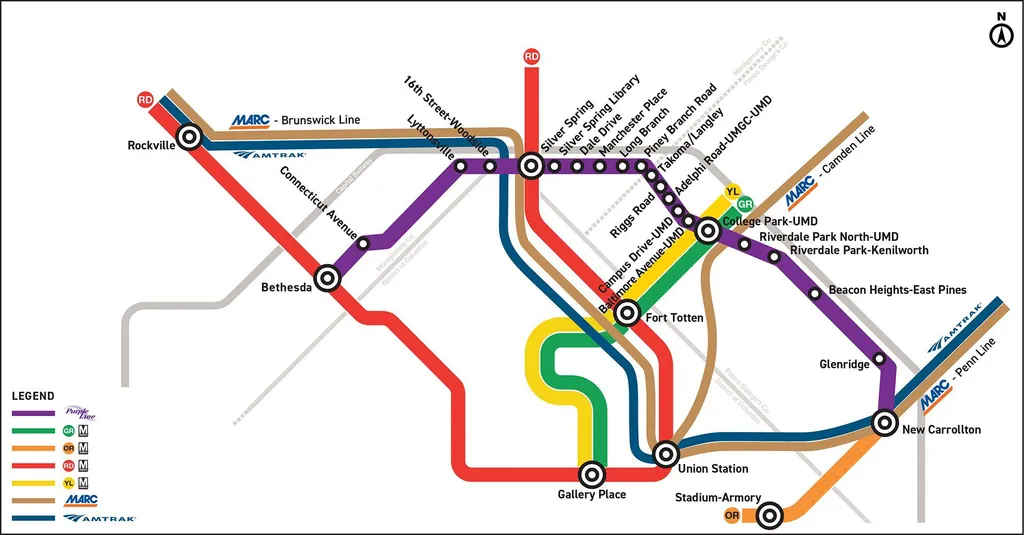- April 18, 2023
- By Maryland Today Staff
Moving around campus this semester feels a bit like maneuvering through a maze, as construction fences, orange traffic barriers and detour signs can turn a trip from points A to B on campus to one that reroutes around L, F and Q.
While the state's construction of the 16-mile light-rail Purple Line is temporarily trying the University of Maryland community's wayfinding skills, at the end awaits a transformative transportation connector that will carry an estimated 65,000 passengers a day and have far-reaching benefits. In the meantime, the university’s oversight groups are collaborating with the Maryland Transit Administration to limit disruptions and make moving around campus as safe and as smooth as possible.
“The Purple Line will bring significant advantages to the university, including improving the way we get around; better connecting campus to the local area and broader region; adding bike lanes; and reducing the need for cars,” said Vice President and Chief Administrative Officer Carlo Colella. “Though the campus community will continue to experience inconvenience and detours during the construction process, we are committed to ensuring the safety of our campus community while working to accelerate the construction schedule to the extent possible.”
That schedule now has the Purple Line slated to open for service by October 2026, with major work on campus complete about a year earlier. Here’s how the new transit system fits into the university’s larger vision and how the years-long project will finally pay off:
Free Rides
Five of the Purple Line’s 21 stations between the New Carrollton Metro Station in Prince George’s County and Montgomery County’s Bethesda station will be on or adjacent to campus: Adelphi Road, Campus Drive, Baltimore Avenue, College Park Metro and Riverdale Park North. UMD students, faculty and staff will be able to ride fare-free among those stops, making traveling from the core of campus to the Discovery District and the Metro faster and easier.
Environmental Impact
The new transit system is an important component of the university's plan to address the grand challenge of climate change by driving down greenhouse emissions related to campus. According to the project’s final environmental impact statement, the Purple Line is projected to create 27,000 new transit trips in the D.C. region and provide 4,000 daily student, employee and visitor trips within 10 years of opening. Within 20 years, it’s projected to take 17,000 cars off the road, reducing gasoline consumption by an estimated 1 million gallons annually.

Get Connected
The Purple Line will also facilitate Terp trips beyond Montgomery and Prince George’s counties, with connections to four Metro stations (including Silver Spring), three MARC lines (Penn, Camden and Brunswick) and Amtrak. That means more options for that errand in D.C., the trek to the airport or a ballgame outing.
Gear Up for Bike Lanes
Rail travel isn’t the only mode of transportation set to get a boost. As part of the Purple Line project, bike lanes will be installed on Campus Drive from the University of Maryland Global Campus on Adelphi Road to Baltimore Avenue. The 10-foot-wide, two-directional path will improve safety for cyclists and microtransit riders, further reducing the need for driving on campus.
Stations’ Artistic Creations
Purple Line passengers can take in new custom art as they wait for their train, with designs from the project’s Art-in-Transit program incorporated into each station. Artists—selected by a committee that included a UMD representative—used inspiration from the stops’ locations in their winning concepts. The College Park Metro stop, for example, features red-and-white checkered elements as a nod to the historic College Park Airport, and the Campus Drive station includes special canopy glass that reflects UMD colors.
Economic Expansion
As UMD continues its Greater College Park initiative, a $2 billion public-private partnership that aims to place the community among the nation’s top college towns, the Purple Line will play a key role in attracting businesses and improving access to campus and the surrounding area. Already, the university has considered proximity to the new line when constructing new buildings, and restaurants, housing and retail could soon follow suit.
The Terrapin Development Company (TDC), a partnership between UMD and its fundraising arm that’s leading several College Park projects, hopes to maximize the impact of the Purple Line’s nearby stops, said Ken Ulman, TDC president and the university’s chief strategy officer for economic development. “By creating mixed-use, vibrant nodes of activity, we will enhance public- and private-sector job creation and enhance opportunities for UMD and our neighbors.”
Purple Line Forum
Vice President and Chief Administrative Officer Carlo Colella will give an update on the Purple Line and answer questions at a forum at 12:15 p.m. today in the Atrium at the Stamp Student Union.
Topics
Campus & CommunityTags
Transportation